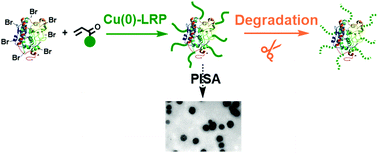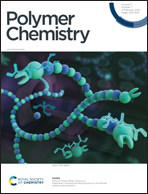Synthesis of lipase–polymer conjugates by Cu(0)-mediated reversible deactivation radical polymerization: polymerization vs. degradation†
Abstract
Polymerization-induced self-assembly (PISA) has evolved as a facile pathway for the in situ formation of polymeric nanomaterials with unique morphologies. However, aqueous PISA by atom transfer radical polymerization (ATRP) for the generation of protein-based nanoassemblies is still challenging. In this research, Candida antarctica lipase B (CALB) is modified as the macroinitiator for Cu(0)-mediated reversible deactivation radical polymerization (Cu(0)-RDRP) of both hydrophilic and hydrophobic monomers in water or water/methanol mixtures. Different acrylamides and acrylates are successfully polymerized in the presence of lipase-based macroinitiators under mild reaction conditions and it is found that the lipase-catalyzed hydrolysis of ester bonds from poly(acrylates) is very significant. The PISA of lipase–hydrophobic polymer conjugates could directly generate spherical nanoparticles in aqueous solution without further processing. Activity tests further demonstrate preservation or even a significant increase of the enzymatic activity for the conjugates, indicating the potential application of aqueous PISA in protein delivery and enzyme immobilization.



 Please wait while we load your content...
Please wait while we load your content...